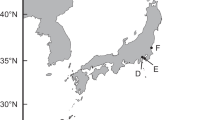Summary
Two of 14 male American kestrels died after 14 and 16 months on a diet containing 2.8 p.p.m., wet weight, p,p′-DDE. The brains of the two birds contained DDE residues of 213 and 301 p.p.m. compared with 14.9 p.p.m. (range, 4.47–26.6 p.p.m.) (wet weights) for 11 of the adult males which were sacrificed after 12 to 16 months on dosage. Autopsies of the two birds compared with autopsies of the sacrificed birds, revealed other characteristics typical of DDE poisoning. Neither bird, when autopsied, displayed characteristics which would suggest that they died of causes other than DDE poisoning.
Similar content being viewed by others
References and notes
HEATH, R. G., SPANN, J. W. and KREITZER, J. F., Nature, 224, 47 (1969).
LONGCORE, J. R., SAMSON, F. B. and WHITTENDALE, T. W., JR., Bull. Env. Cont. Toxicol., 6, 485 (1971).
WIEMEYER, S. N. and PORTER, R. D., Nature 227, 737 (1970).
WALKER, C. H., HAMILTON, G. A. and HARRISON, R. B., J. Sci. Fd. Agric., 18, 123 (1967).
STICKEL, W. H.,In Peregrine Falcon Populations, Their Biology and Decline. (edit. by Hickey, J. J.), 474 (Univ. Wisconsin Press, Madison, 1969).
STICKEL, W. H., STICKEL, L. F. and COON, F. B.,In Pesticide Symposia, Seventh International Conference on Toxicology and Occupational Medicine (edit. by Deichmann, W. B., Radomski, J. L. and Penalver, R. A.), 287 (Halos and Assoc., Inc., Miami, 1970).
BAILEY, S., BUNYAN, P. J., RENNISON, B. D. and TAYLOR, A., Toxicol. Appl. Pharmacol., 14, 13 (1969).
Ibid., 14, 23 (1969).
GILL, J. A., VERTS, B. J. and CHRISTENSEN, A. G., J. Wildl. Mgmt., 34, 223 (1970).
ABOU-DONIA, M. B. and MENZEL, D. B., Biochem. Pharmacol., 17, 2143 (1968).
PORTER, R. D. and WIEMEYER, S. N., J. Wildl. Mgmt., 34, 594 (1970).
JENSEN, S., JOHNELS, A. G., OLSSON, M. and OTTERLIND, G., Nature, 224, 247 (1969).
CRAMP, S., Brit. Birds, 56, 124 (1963).
AMES, P. L. and MERSEREAU, G. S., Auk, 81, 173 (1964).
AMES, P. L., J. Appl. Ecol., 3 (suppl.), 87, (1966).
BROLEY, C. L., Audubon Mag., 60, 162 (1958).
LOCKIE, J. D. and RATCLIFFE, D. A., Brit. Birds, 57, 89 (1964).
RATCLIFFE, D. A.,In Peregrine Falcon Populations, Their Biology and Decline. (edit. by Hickey, J. J.), 239, (Univ. Wisconsin Press, Madison, 1969).
ANDERSON, D. W. and HICKEY, J. J., Proc. XV International Ornith. Congress, (in the press).
CADE, T. J., LINCER, J. L., WHITE, C. M., ROSENEAU, D. G. and SWARTZ, L. G., Science, 172, 955 (1971).
KEITH, J. O., WOODS, L. A. and HUNT, E. G., Trans. N. Am. Wildl. Conf., 35, 56 (1970).
REICHEL, W. L., CROMARTIE, E., LAMONT, T. G., MULHERN, B. M., and PROUTY, R. M., Pesticide Monitor. J., 3, 142 (1969).
MULHERN, B. M., REICHEL, W. L., LOCKE, L. N., LAMONT, T. G., BELISLE, A., CROMARTIE, E., BAGLEY, G. E. and PROUTY, R. M., Pesticide Monitor. J., 4, 141 (1970).
CADE, T. J., WHITE, C. M. and HAUGH, J. R., Condor, 70, 170 (1968).
DUSTMAN, E. H., STICKEL, L. F., BLUS, L. J., REICHEL, W. L. and WIEMEYER, S. N., Trans. N. Am. Wildl. Conf., 36, 118 (1971).
LINEER, J. L., CADE, T. J. and DEVINE, J. M., Canadian Field-Nat., 84, 255 (1970).
We have compared the skins of our kestrels on a lipid weight basis with the fat samples of pelicans on a wet weight basis as given by Keith, Woods, and Hunt (14). The fat of pelicans contained DDE residues (14) on a wet weight basis of a magnitude equal to the lipid weight basis of our kestrel skins. Since lipid weight values are always higher than wet weight values for the same sample (see Table 1), the residues of DDE in pelican fat on a lipid weight basis would be higher than those in our kestrels on a similar basis. We, therefore, consider these residues to be comparable.
ENDERSON, J. H. and BERGER, D. D., Auk, 85, 683 (1968).
KEITH, J. O. and HUNT, E. G., Trans. N. Am. Wildl. Conf., 31, 150 (1966).
WALKER, C. H. and MILLS, D. H., Wildfowl Trust 16th Ann. Rpt., 56 (1965).
MARTIN, W. E., Pesticide Monitor. J., 3, 102 (1969).
HEATH, R. G., Pesticide Monitor. J., 3, 115 (1969).
CULLEY, D. D. and APPLEGATE, H. G., Pesticide Monitor. J., 1, no. 2, 21 (1967).
APPLEGATE, H. G., Pesticide Monitor. J., 4, 2 (1970).
JOHNSON, D. W. and LEW, S., Pesticide Monitor. J., 4, 57 (1970).
HENDERSON, C., JOHNSON, W. L. and INGLIS, A., Pesticide Monitor. J., 3, 145 (1969).
HENDERSON, C., INGLIS, A. and JOHNSON, W. L., Pesticide Monitor. J., 5, 1 (1971).
FINDLAY, G. M. and DEFREITAS, A. S. W., Nature, 229, 63 (1971).
BERNARD, R. F., Mich. State Univ., Publ. of Mus., Biol. Ser., 2, 155 (1963).
Author information
Authors and Affiliations
Rights and permissions
About this article
Cite this article
Porter, R.D., Wiemeyer, S.N. DDE at low dietary levels kills captive American kestrels. Bull. Environ. Contam. Toxicol. 8, 193–199 (1972). https://doi.org/10.1007/BF01839511
Issue Date:
DOI: https://doi.org/10.1007/BF01839511




